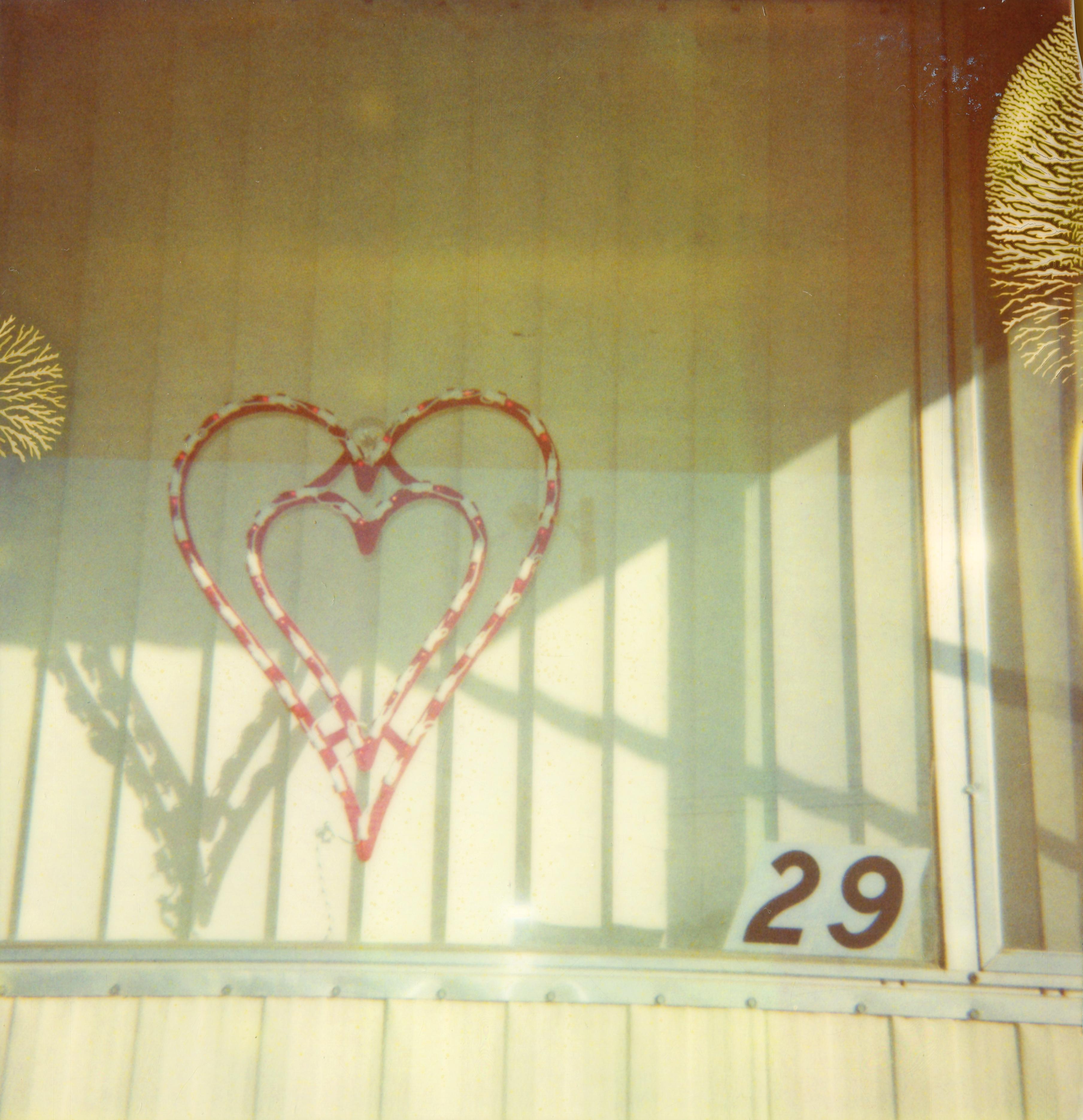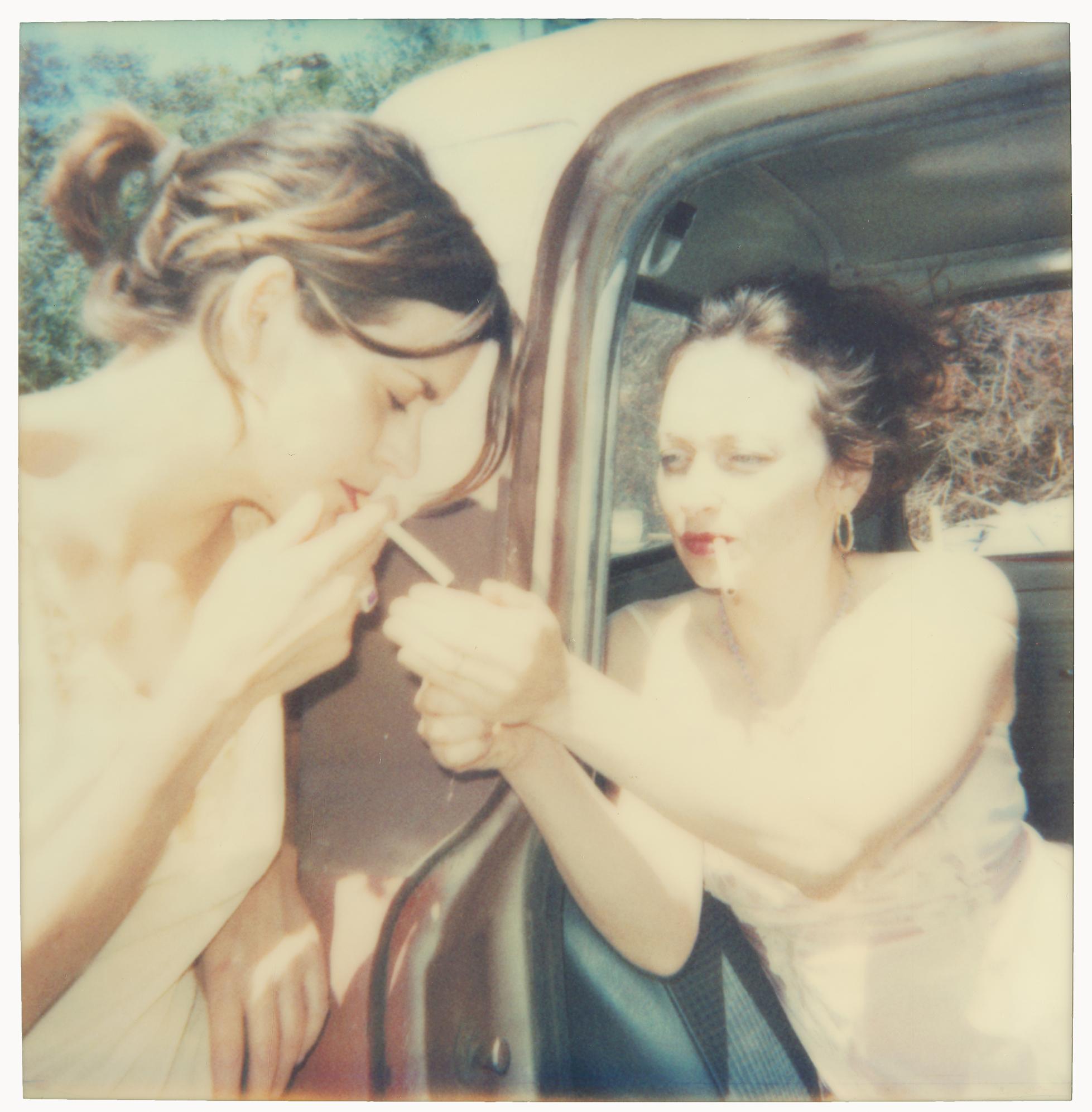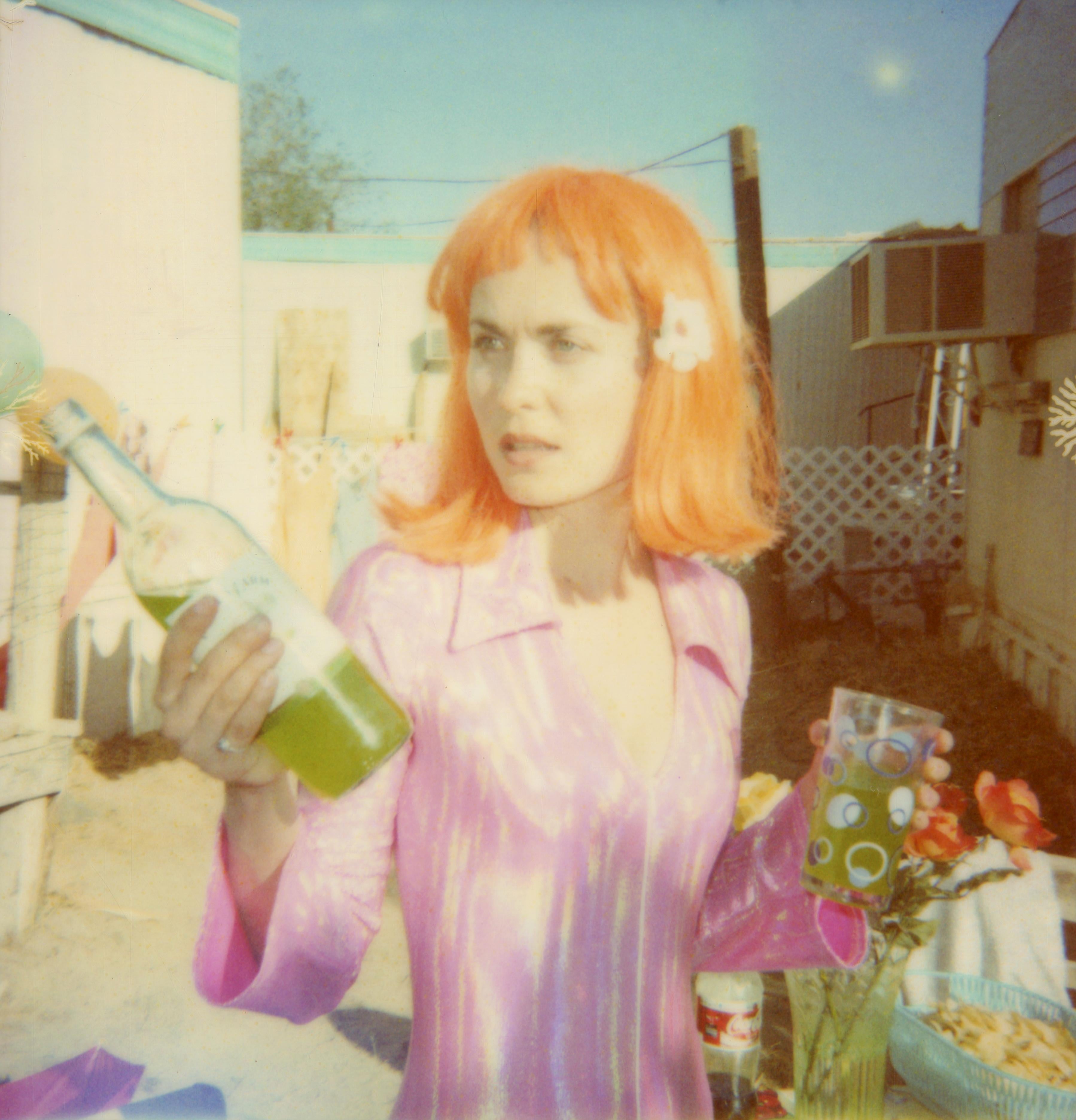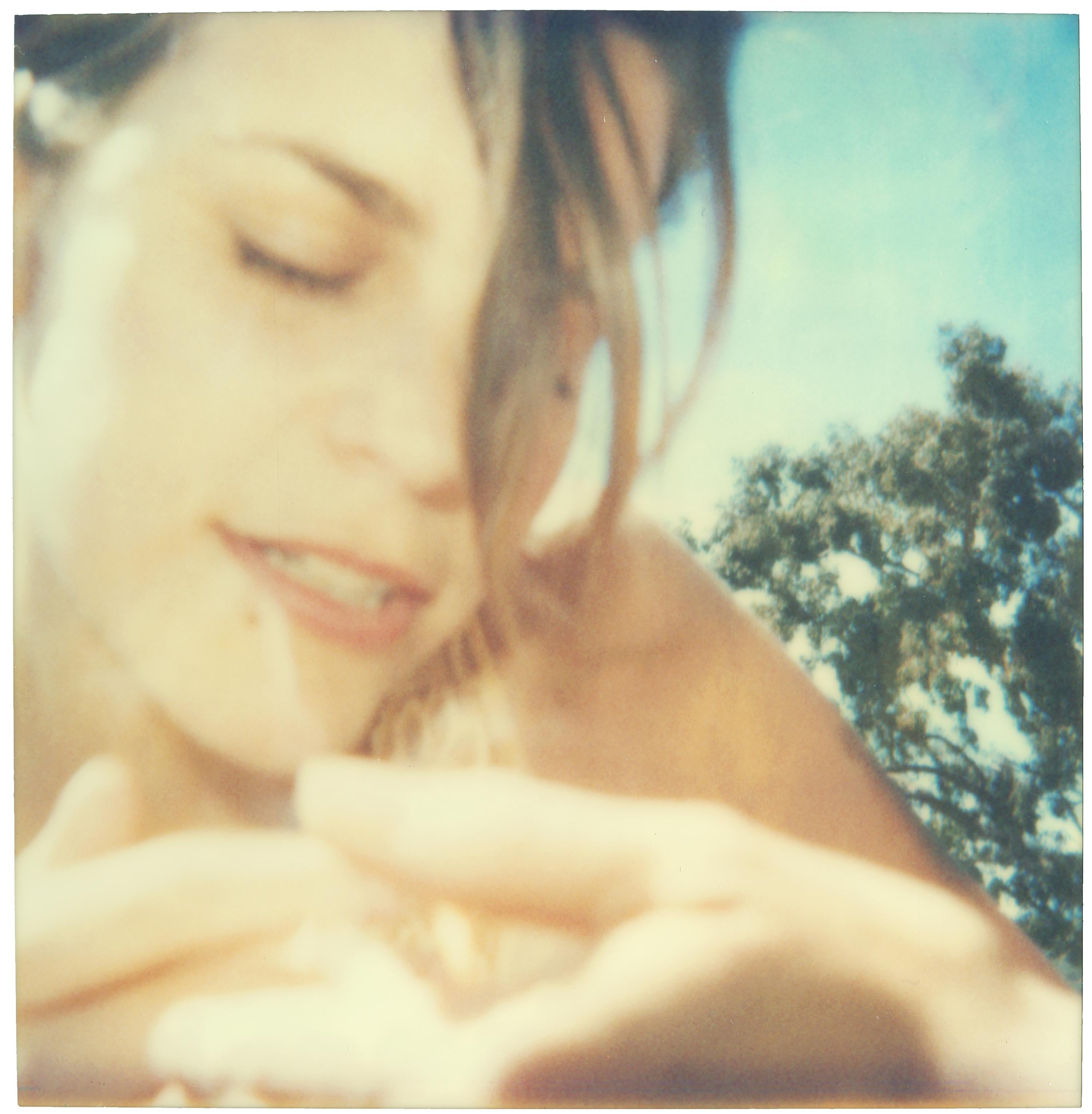Desert Center (Stranger than Paradise) - 2000
Edition of 10,
48x60cm.
Archival Print, based on the Polaroid.
Mounted on dibond with matte UV-Protection.
Signature label and Certificate.
Artist Inventory No. 534.
Published in Stranger than Paradise, Hatje Cantz (monograph)
Stefanie Schneider: A Discovery on Polaroid.
An essay by Eugen Blume
How is it that the photographic works of Stefanie Schneider do not allow anything other than one single association, namely that of America? Because they were taken in America itself? That fact alone would not yet be a compelling argument. Many photographs of America possess a reckless ambivalence which allows even the different country of their own particular creator to seem so similar as to be confused with America itself. Does this ambiguity have something to do with the ongoing, accelerating Americanization of the entire world? Or is it simply connected with our personal clichés which we attribute to a country the size of North America as valid expressions of its very essence, thereupon negligently allowing it not only to dwindle down into any size whatever, but also to expand to a great extent, from Germany by way of Luxembourg right through to Japan?
Now it is certainly true that the figures of Thelma and Louise in the desert do not represent an American reality, not even after their resurrection as Radha and Max in the series 29 Palms from 1999. Strangely enough, it is nature which allows this utterly artificial scene to grow into an American verity. The harsh sunlight in the barren landscape establishes the fundamental tone out of which the women emerge in excessive hysteria from beneath their colored wigs. It is inherently absurd to celebrate the feminine aspect in the middle of a mercilessly inhospitable environment. The image of the two women is a monument of resistance, the meaningful assertion of a lifestyle which stands in contradiction to each and every convention. The pictorial structure and the captured movement along the edge of the format are a means of blending the glaring luminosity with the plot in a manner which perhaps functions successfully only in the “simple” instant technique of the Polaroid. Stefanie Schneider’s pictorial narratives are striking in their formal elegance. She utilizes the chemical faults of the Polaroids, their tendency towards overexposure and double-images as a sovereignly controlled means of artistic design. The defects become, as it were, metaphorical levels which plumb depths lying far beneath the surface. The overly bright colors and schlieren seek out the uncanny; they provide a counterweight to a narration that is deliberately kept superficial. They tell of an invisible strand. They illuminate, in the truest sense of the word, underground processes. Although we are familiar with a series featuring American flags which could not indicate the site of its narrations any more clearly, nevertheless there remains a fundamental doubt as to whether the initially described association with America is identical with that which we deem to be America in a geographical sense.
Although I have in the meantime been in America several times, in both South and North America, deep down I remain uncertain as to whether the New World actually exists. Columbus’ error of continuing to believe, even when having arrived on land, that he was encountering the India which was the actual goal of his journey has burrowed down deep into the European unconscious as a cultural convention. Peter Bichsel’s amusing story “Amerika gibt es nicht” (There is no America) still remains today an undeniable truth: America’s northern half is a film, not a continent. Everything which signifies the U.S.A. – from the Indians, whose most noble savages were invented in Europe, all the way to September 11th and the subsequent war in Iraq, the aliens and the revival of the dinosaurs, the terminators as governors and presidents as actors and vice versa, the electric chairs, the godfather Marlon Brando and the eternal singer Bob Dylan, the neurotic Woody Allen, Velvet Underground and Andy Warhol – all this is an invention of the media. Everything that I know about America has been conveyed to me by Hollywood films.
My trip into this fictional wonderland, this country where nothing seems impossible, began with a landing at Kennedy Airport, along with a list of questions investigating my existence up to that point in time and inquiring whether I belonged or belong to any Communist organization. There went by three long hours of waiting, without my having seen anything that was actually real, among variously colored passengers until there was a call to board my flight to Houston, Texas, the destination of my first trip to America. The airplane traveled for an endless stretch of time just to reach the take-off runway and thereby crossed bridges under which dense auto traffic flowed ceaselessly towards somewhere, like a never-ending caravan. My little onboard window was nothing more than a monitor tuned to one of the many road movies at which I gazed in boredom. Finally the machine came to a standstill and the massive doors were opened, warm air hung heavily amid functional concrete buildings and a few palms: I was in the southern region of North America. In front of the airport was the usual scene from the beginning of a film viewed hundreds of times: yellow cabs with black drivers. Along the highway to Houston, seen from car windows that were once again nothing more than monitors, there rose up upon high poles to the right and left vastly oversized, widescreen-formatted billboards advertising everything that for a long time now we in Europe have internamericalized: Coca-Cola in an immediate love-hate relationship to Pepsi, the successful taste plagiarizer, McDonald’s, cornflakes. Concrete streets above and below me, in the distance the skyline of Houston set against the background of the desert: high-quality Cinemascope. Spontaneously there came to mind the first scenes of Tarkovsky’s Solaris, that never-ending stretch of concrete, filmed from within the automobile which, remotely controlled, brings its passenger somewhere, anywhere, just not into reality.
I didn’t understand the first Texan whom I met; the ponderous dialect, spoken in the interior of his mouth, was not compatible with my knowledge of English. America was not only a film but also a collection of clichés. In the evening I attended the opening of an museum exhibition, which was the actual reason for my journey: rich women wearing fur coats in approximately thirty degrees Centigrade; first the buffet, then the art; no wordily wandering speeches, but rather everything economically tailored to momentary pleasure and external appearance. Modern Houston was nothing more than a city of offices; the last skyscrapers in the series already end in the desert sand; some are nailed up and carry signs of warning: “Contaminated with Asbestos.” In the bus I am the only white person among variously hued immigrants from South America or scions of long-established families of former slaves, and I myself am marveled at like a strange, stray soul. In search of the DeMenil Collection amid endless single-family dwellings, there was the usual action scene: an identity check, police vehicles outfitted with sirens and sporting double, revolving lights upon their roofs, the role of the sheriff well cast, a successful sequence filmed on the first take and put right in the can. I am not given any trouble with my status as a European, such as can easily be seen from my passport. The whole atmosphere is friendly, suffused with an almost unbelievable amicality. The colleagues in the Museum of Fine Arts, an astounding universal museum with artworks ranging from antiquity all the way to the present and a Mies van der Rohe building extension, are enthusiastic about my idea of traveling on to California as soon as possible.
Beneath me a nature film presented by National Geographic, the Grand Canyon, red cliffs of incredible dimensions, somewhere Death Valley and Hollywood, to which I owe so much. In San Francisco friends are waiting for me at the airport, two American biographies such as are only written here. Everything is just as I know it, the soundtrack is right on the money: Crosby, Stills, Nash and Young, and up further in the surf, the Beach Boys. The Golden Gate Bridge in fog, the wonderful district of Sausalito, and far across the bay the city of Oakland. A paradise of hippies, twenty degrees Centigrade as the average annual temperature. William Seward Burroughs is reading in a bookshop, Alan Ginsburg, and somewhere Patti Smith is singing. I do not intend to write here about my next destination, New York City, not about the wonderful people who were my hosts, not about Mildred the pianist, who worked with John Cage, not about her husband, the painter who was friends with Alexander Calder…
When I recall this first trip to America, my images are strangely blurred in their colors, and the sharply focused photographs which I have kept among many useless ones convey nothing of that which remains in my head. I think back to the magical places, just like to the inhospitable ones, from a certain aesthetic perspective, and it is this very aesthetic which I rediscover in the pictures of Stefanie Schneider. Tales of America, a discovery on Polaroid.
Basically we know nothing about how our remembered images in fact look; we believe that we recall pictures and we tell of images which nocturnal dreams implant in our brains, but we would have great difficulty in specifying their actual form. From time to time we consider ourselves to have seen distinct pictures, but mostly we think of blurred appearances, more of shadows than of sharp contours. For her part, Stefanie Schneider as a native German sees her chosen country of residence as if in a dream. She stages a land which does not exist, a land of visions and spirits. During 2005 in the film Hitchhiker and in the photo series Sidewinder, she tells about love in terms of the hippie clichés of the 1960s: the long-haired girl with no makeup together with the preacher in a trailer amid the eternal heat, God’s warm canopy above California, Jack Daniels as the celebratory wine of the mass, the Colt revolver as a breviary, and no happy end. This is a biblical tale about man and woman caught between violence and tenderness in the solitude of a grandiose landscape and amid the theater props of a distant civilization.
Elsewhere, in the middle of overpowering nature, there stands the artificial woman with falsely colored hair, too gaudy for God’s world, too confrontatory for bigoted America. The girls apply an excessive amount of makeup; they are obsessed with being ready for a great romantic adventure, for that one grandiose explosion of fireworks in which they are to be consumed in place of all the others who remain respectable. They are Lolitas beside the pool and in the desert, sirens who beguile the man with their song, rob him of reason, and yearn to be consumed by fire together with him in the American desert. Life as film – there is no reality anywhere.
Stefanie Schneider’s pictures oscillate between photography and painting. Their large-format Polaroids, if one recalls the now-inflationary painting over photos which was initiated by the Belgian Luc Tuymans, convey the impression of paintings without actually being paintings. That which the first photographers of the nineteenth century still attempted out of an inferiority complex due to their technology, namely to attain the status of art through painterly quality, is accomplished by Stefanie Schneider as an interesting intermediate segment in the current, self-assertive discourse of pictorial photography. My own interest is occasioned not only by her stories, which are suffused with a strangely intentional banality and pursue a narrative minimalism that is satisfied with clichés and adds nothing other than yet another variation on only too well known, utterly depleted plot material, but also by the gestalt which she has discovered and which makes an aesthetic approach to the phenomenon of memory. Everything which we do and experience has already become memory after the occurrence of an immediate action, and it may only be summoned up as a blurred function of memory. That which is real and possesses its own unique quality becomes lost in the act of remembrance and is yielded over to an ambivalence which is easily capable of finding witnesses with varying voices. Every endeavor to portray something “as it really is” already exhausts itself through the insufficiency of our thought. Only poetry, which naively devotes itself to ambivalence and which knows of a different precision than the bureaucratic requirements of the historical genre, is capable of retrieving the actual occurrence. Gazing upon the pictures of Stefanie Schneider, I remember my first visit to America more exactly than with the support of the notes which I wrote down or the books and tourist aids which I took along. Almost in shock, I stand in front of blurred colors, fragments resulting from badly aimed lenses, chemical deletions of instant photos opened up too quickly, and I summon into remembrance a land that does not exist in reality.
Translated by George Frederick Takis





